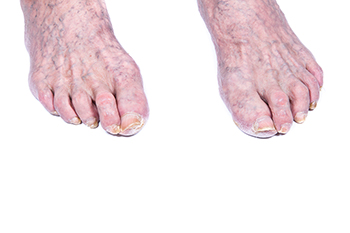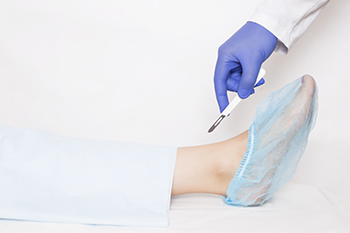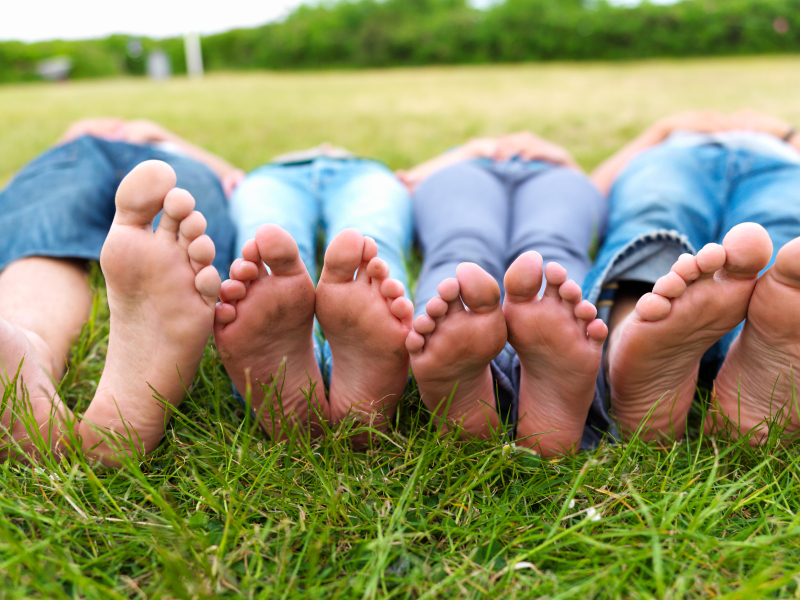Blog
Items filtered by date: October 2023
The Characteristics of Elderly Feet

As we journey through life, our bodies undergo a multitude of changes, and our feet are no exception. The feet of the elderly have unique characteristics that reflect the wear and tear of a lifetime. One of the most noticeable features is the gradual flattening of the arches, causing a broader, flatter foot shape. This can result in a greater risk of instability and falls. Skin changes are also common, with thinning skin that is more susceptible to injury and slower healing. Additionally, years of weight-bearing can lead to conditions such as bunions, hammertoes, and arthritis, which may cause pain and reduced mobility. Toenails may thicken, and the risk of fungal infections or ingrown nails increases. Circulation issues, often linked to diabetes or other medical conditions, can further complicate matters. Despite these changes, elderly feet are resilient, and with proper care, they can continue to support a fulfilling, active life. Understanding the characteristics of elderly feet is crucial for maintaining overall health and well-being. If you would like information about proper foot care for elderly people, it is suggested that you contact a podiatrist who can provide you with the knowledge you are seeking.
Proper foot care is something many older adults forget to consider. If you have any concerns about your feet and ankles, contact David Lambarski, DPM from Northeast Foot Care. Our doctor can provide the care you need to keep you pain-free and on your feet.
The Elderly and Their Feet
As we age we start to notice many changes in our body, but the elder population may not notice them right away. Medical conditions may prevent the elderly to take notice of their foot health right away. Poor vision is a lead contributor to not taking action for the elderly.
Common Conditions
- Neuropathy – can reduce feeling in the feet and can hide many life-threatening medical conditions.
- Reduced flexibility – prevents the ability of proper toenail trimming, and foot cleaning. If left untreated, it may lead to further medical issues.
- Foot sores – amongst the older population can be serious before they are discovered. Some of the problematic conditions they may face are:
- Gouging toenails affecting nearby toe
- Shoes that don’t fit properly
- Pressure sores
- Loss of circulation in legs & feet
- Edema & swelling of feet and ankles
Susceptible Infections
Diabetes and poor circulation can cause general loss of sensitivity over the years, turning a simple cut into a serious issue.
If you have any questions please feel free to contact our offices located in Amsterdam and Clifton Park, NY . We offer the newest diagnostic and treatment technologies for all your foot and ankle needs.
What is Joint Replacement Surgery?

Joint replacement surgery is a procedure that involves the removal of damaged or diseased portions of a joint and their replacement with artificial components. This surgery becomes necessary when joints deteriorate due to factors like arthritis, prolonged wear and tear, or underlying medical conditions. The primary objectives of foot or ankle joint replacement surgery are to alleviate pain, enhance joint functionality, and improve mobility. Before considering such surgery, podiatrists typically explore alternative treatments, such as exercise regimens, walking aids like canes or walkers, physical therapy, and medications to manage pain and inflammation. While joint replacement surgery can significantly improve a patient's quality of life, it is not without risks. Potential complications include postoperative infections, blood clot formation, and the eventual erosion of the artificial joint surface, which may require revision surgery after 15 to 20 years. If you are experiencing foot or ankle joint issues that have not responded to more conservative treatment, it is suggested that you make an appointment with a podiatrist to discuss whether joint replacement surgery is a viable treatment option for you.
In certain cases, in which the patient suffers from extreme pain or damage in a joint, joint replacement surgery may be deemed useful. If you have constant pain in a foot joint, consult with David Lambarski, DPM from Northeast Foot Care. Our doctor will assess your condition and provide you with quality foot and ankle treatment.
What Is Joint Replacement Surgery?
Over time, joints wear down; this can be exacerbated by diseases and conditions. Joint replacement surgery, also known as arthroplasty, is when a damaged joint is surgically removed and replaced with a prosthesis. Prostheses, which can be made of ceramic, plastic, or metal, act as joints in lieu of an actual joint. One of the most prevalent causes for joint replacement is arthritis.
Arthritis in the Foot
Arthritis can occur in any joint in the body, including in the feet. Common types of arthritis in the foot are osteoarthritis, rheumatoid arthritis, and gout. The big toe is usually where arthritis occurs in the foot; this is known as hallux rigidus.
Joint Replacement Surgery in the Foot
The most common form of joint replacement in the foot is a first metatarsophalangeal (MTP) joint placement. MTP joint replacement surgery is designed to treat hallux rigidus. Surgery is not intensive, and recovery occurs within one to two months after the procedure has been done. Overall, joint replacement surgery is a safe and effective way to treat pain in the joint of the foot.
If you have any questions, please feel free to contact our offices located in Amsterdam and Clifton Park, NY . We offer the newest diagnostic and treatment technologies for all your foot care needs.
Seed Corns are Troublesome Growths

Seed corns, also known as porokeratotic eccrine ostial and dermal duct nevus, are small, painful, and often frustrating foot conditions. These minuscule, discreet calluses typically appear on the soles of the feet and can be mistaken for small plantar warts due to their size and appearance. Unlike warts, seed corns are usually found in clusters and are more likely to cause discomfort when walking or standing. The name seed corn is derived from their resemblance to tiny seeds, which can make them difficult to detect and remove effectively. While their exact cause is not entirely clear, factors consisting of friction, pressure, or certain types of shoes may contribute to their development. Fortunately, proper foot care, gentle exfoliation, and the use of moisturizing creams can help manage these bothersome seed corns, providing relief and comfort to those affected. If you have developed seed corns, seeking advice from a podiatrist is suggested for appropriate treatment and long-term prevention.
Corns can make walking very painful and should be treated immediately. If you have questions regarding your feet and ankles, contact David Lambarski, DPM of Northeast Foot Care. Our doctor will treat your foot and ankle needs.
Corns: What Are They? And How Do You Get Rid of Them?
Corns are thickened areas on the skin that can become painful. They are caused by excessive pressure and friction on the skin. Corns press into the deeper layers of the skin and are usually round in shape.
Ways to Prevent Corns
There are many ways to get rid of painful corns such as:
- Wearing properly fitting shoes that have been measured by a professional
- Wearing shoes that are not sharply pointed or have high heels
- Wearing only shoes that offer support
Treating Corns
Although most corns slowly disappear when the friction or pressure stops, this isn’t always the case. Consult with your podiatrist to determine the best treatment option for your case of corns.
If you have any questions please feel free to contact our offices located in Amsterdam and Clifton Park, NY . We offer the newest diagnostic and treatment technologies for all your foot and ankle needs.
We Can Treat Your Foot or Ankle Pain
Footwear and Children’s Foot Health

Active kids take about 20,000 steps a day, making the choice of shoes important for their foot health. Conventional shoes can distort natural foot structures, leading to musculoskeletal issues over time. Adult feet and conventional adult shoes share a similar shape, which is not a coincidence. Many foot problems, such as bunions and heel pain, that are seen in western societies are rare in cultures where people walk mostly barefoot. This may suggest that certain footwear affects foot shape negatively. Parents can opt for children’s shoes that are widest at the toes, flat, lightweight, and have flexible soles. Avoid arch support or pronation control features as these can interfere with natural foot development. It is also acceptable to allow your child to walk barefoot occasionally, as feet are adaptable. However, always be cautious about unsafe surfaces. Making these simple choices can contribute to the healthy development of your child’s feet. If you want to make sure that your child’s feet have the best chance of developing healthfully, it is suggested that you make an appointment with a podiatrist for an evaluation and discussion on how to best do this.
Making sure that your children maintain good foot health is very important as they grow. If you have any questions, contact David Lambarski, DPM of Northeast Foot Care. Our doctor can provide the care you need to keep you pain-free and on your feet.
Keeping Children's Feet Healthy
Having healthy feet during childhood can help prevent medical problems later in life, namely in the back and legs. As children grow, their feet require different types of care. Here are some things to consider...
Although babies do not walk yet, it is still very important to take care of their feet.
Avoid putting tight shoes or socks on his or her feet.
Allow the baby to stretch and kick his or her feet to feel comfortable.
As a toddler, kids are now on the move and begin to develop differently. At this age, toddlers are getting a feel for walking, so don’t be alarmed if your toddler is unsteady or ‘walks funny’.
As your child gets older, it is important to teach them how to take care of their feet.
Show them proper hygiene to prevent infections such as fungus.
Be watchful for any pain or injury.
Have all injuries checked by a doctor as soon as possible.
Comfortable, protective shoes should always be worn, especially at play.
If you have any questions please feel free to contact our offices located in Amsterdam and Clifton Park, NY . We offer the newest diagnostic and treatment technologies for all your foot and ankle needs.
Tips to Improve Blood Flow in the Feet

Proper circulation is essential for overall health, and when it comes to your feet, it is no different. Poor circulation in the feet can lead to coldness and a numbing and tingling sensation. Fortunately, there are several strategies that can enhance blood flow to your feet. It is important to understand that engaging in a regular exercise routine is a game changer. Activities such as walking, swimming, and yoga can get your blood pumping and improve circulation. Foot exercises, such as toe taps and ankle rotations, can be particularly beneficial. Maintaining a healthy weight is crucial, as excess body fat can impede blood flow. A balanced diet rich in fruits, vegetables, and whole grains can aid in weight management and overall circulation. Elevating your feet whenever possible, especially after a long day, may help to reduce swelling and can encourage blood flow back to your heart. Wearing proper footwear is essential. Choose comfortable, well-fitting shoes that provide support and do not constrict blood vessels. Additionally, it is beneficial to avoid smoking and limit caffeine intake, as these can contribute to poor circulation. Finally, stay hydrated and manage stress, as they both negatively impact circulation. If you have poor circulation, it is suggested that you speak with a podiatrist who can provide you with additional relief tips.
Poor circulation is a serious condition and needs immediate medical attention. If you have any concerns with poor circulation in your feet contact David Lambarski, DPM of Northeast Foot Care. Our doctor will treat your foot and ankle needs.
Poor Circulation in the Feet
Poor blood circulation in the feet and legs is can be caused by peripheral artery disease (PAD), which is the result of a buildup of plaque in the arteries.
Plaque buildup or atherosclerosis results from excess calcium and cholesterol in the bloodstream. This can restrict the amount of blood which can flow through the arteries. Poor blood circulation in the feet and legs are sometimes caused by inflammation in the blood vessels, known as vasculitis.
Causes
Lack of oxygen and oxygen from poor blood circulation restricts muscle growth and development. It can also cause:
- Muscle pain, stiffness, or weakness
- Numbness or cramping in the legs
- Skin discoloration
- Slower nail & hair growth
- Erectile dysfunction
Those who have diabetes or smoke are at greatest risk for poor circulation, as are those who are over 50. If you have poor circulation in the feet and legs it may be caused by PAD and is important to make changes to your lifestyle in order to reduce risk of getting a heart attack or stroke. Exercise and maintaining a healthy lifestyle will dramatically improve conditions.
As always, see a podiatrist as he or she will assist in finding a regimen that suits you. A podiatrist can also prescribe you any needed medication.
If you have any questions please feel free to contact our offices located in Amsterdam and Clifton Park, NY . We offer the newest diagnostic and treatment technologies for all your foot and ankle needs.

